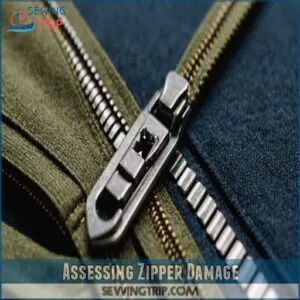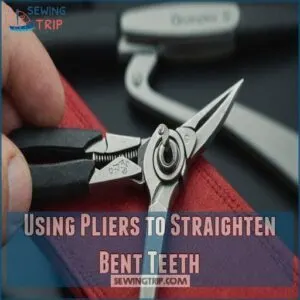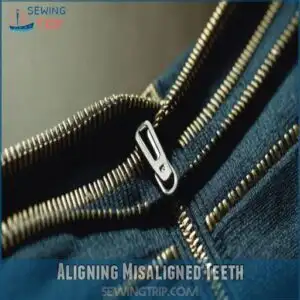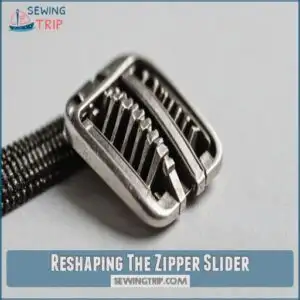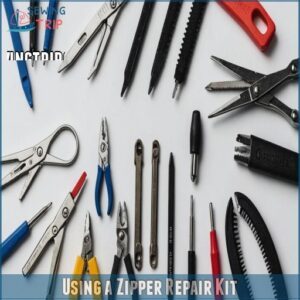This site is supported by our readers. We may earn a commission, at no cost to you, if you purchase through links.
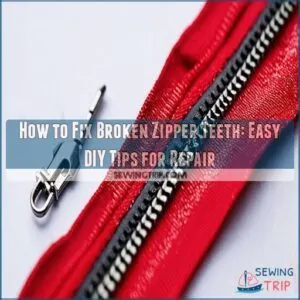
First, gently clean the zipper with soapy water, giving those teeth a fresh start.
If they’re misaligned, use pliers to carefully realign them, like coaxing stubborn puzzle pieces into place.
Sometimes, the slider just needs a little TLC—try reshaping it with gentle pressure.
If teeth are missing, a zipper repair kit can be your best friend, providing replacement teeth and stops.
For a quick fix, a dab of candle wax might ease stubborn glides.
Still wrestling with that zipper? There’s more to zip through in our detailed guide!
Table Of Contents
- Key Takeaways
- Assessing Zipper Damage
- Preparing for Repair
- Realigning and Reshaping Zipper Teeth
- Replacing Missing Zipper Teeth
- Fixing Specific Zipper Issues
- Lubricating and Maintaining Zippers
- Replacing The Zipper Slider
- Temporary Solutions for Broken Zippers
- Special Considerations for Invisible Zippers
- Professional Repair and Replacement Options
- Frequently Asked Questions (FAQs)
- Conclusion
Key Takeaways
- Inspect the zipper’s slider and teeth closely to determine the issue before starting any repair to ensure you’re using the right method.
- If teeth are bent or misaligned, use pliers to gently straighten or realign them, being careful not to apply too much force.
- For missing teeth, consider using a zipper repair kit with replacement parts or replace the entire zipper for a more permanent solution.
- Regular maintenance, like cleaning with soapy water and lubricating with candle wax, helps keep zippers functioning smoothly and prevents future issues.
Assessing Zipper Damage
Before you start fixing that frustrating zipper, let’s figure out exactly what’s wrong.
Take a close look at the slider, the teeth, and the fabric; this careful inspection will help you choose the right repair method.
Inspecting The Zipper Slider
Ever wonder why your zipper’s giving you grief? Check the slider! It might be worn or misaligned. Luckily, it’s easy to inspect:
- Look for slider wear and uneven openings.
- Check slider tension for snug fits.
- Align the slider properly.
- Make sure the slider size fits the zipper.
- Consider the slider material for durability.
Checking for Missing or Bent Teeth
With keen eye and a little know-how, checking for missing or bent zipper teeth becomes a breeze.
Visual inspection is your first step.
Notice gaps in tooth alignment? It’s often due to a damaged slider or particular zipper type.
Keep repair tools handy—gentle pliers work wonders.
Such careful care gives you mastery over those stubborn zippers!
Identifying Fabric Tears or Separation
Spotting fabric tears near zippers can seem like finding Waldo on a busy page, yet it’s important.
Tears spell trouble, hinting at stress points or stitching issues.
Keep an eye out for:
- Fraying edges
- Gaps along seams
- Discoloration from wear
- Misaligned zipper tapes
- Holes where teeth start or end
These wear patterns signal seam separation needing attention.
Preparing for Repair
Before you tackle fixing those pesky zipper teeth, make sure you’ve gathered all necessary tools and materials like pliers and a zipper repair kit.
Then, carefully remove the old slider and stops, and clean the zipper tracks to give yourself a fresh start.
Gathering Tools and Materials
After spotting the zipper damage, get your hands on the necessary tools and basic materials.
A zipper repair kit is your best friend here—think of it as your DIY supplies go-to.
Add pliers, scissors, and some lubricating oil to your kit.
It’s like assembling a toolset for a zipper surgery, setting the stage for a smooth repair.
Removing The Old Slider and Stops
Removing the old slider and stops can seem challenging, but with the right approach, it’s straightforward.
Here’s how:
- Gather the Tools: Get pliers and a flathead screwdriver.
- Identify Stop Types: Metal or plastic, you’ll need to pry them carefully.
- Zipper Release: Gently wiggle the slider off, minding safety precautions to avoid damaging the fabric.
Cleaning The Zipper Tracks
Before tackling those stubborn zipper teeth, give the tracks a good cleaning!
Use a soft brush and some mild soap to remove any dirt or lint.
A toothpick can help dislodge stubborn bits.
This Track Inspection makes sure smooth sailing.
A little Track Lubrication with soap or wax can work wonders.
Trust me, clean tracks make all the difference.
Now you’re ready to fix that zipper!
Realigning and Reshaping Zipper Teeth
Getting your zipper back on track involves straightening bent teeth and reshaping the slider with careful precision.
Use pliers gently; you want to fix the misalignment, not start a wrestling match with your zipper.
Using Pliers to Straighten Bent Teeth
Got a bent zipper tooth? Grab your pliers.
Different types work, but needle-nose ones are great for precision.
Gently grip the tooth and twist it straight.
Avoid squeezing too hard—it’s like trying to fix a bent paperclip; too much force could snap it!
Use steady hands and a gentle grip to avoid common mistakes and make sure you’re staying safe.
Aligning Misaligned Teeth
After tackling bent teeth, it’s time to align those misbehaving zipper teeth.
You’ll need patience and maybe a zipper alignment tool.
Carefully press the teeth together, ensuring they interlock correctly.
To prevent future misalignments, make sure to secure fabric around zippers.
Remember, a zipper repair kit can be your best friend here.
It’s like a dance; each tooth has to meet its partner to zip smoothly.
Reshaping The Zipper Slider
When the zipper’s being stubborn, your slider might need some TLC.
Over time, slider wear can lead to an uneven opening, reducing zipper pressure and causing hiccups.
If the damage is more severe, consider visiting a website that sells zipper teeth fix products for a more permanent solution.
Use pliers to gently adjust the slider opening without over-squeezing—it’s like Goldilocks; you want it just right.
This can extend your slider’s lifespan and get things zipping smoothly again!
Replacing Missing Zipper Teeth
Replacing missing zipper teeth isn’t as tricky as it seems when you’ve got the right tools on hand.
You’ll need a zipper repair kit or an old zipper to cut and glue new teeth, and sometimes, adding a new bottom stopper is key to getting things back on track.
Using a Zipper Repair Kit
With the slider realigned, it’s time to grab your trusty zipper repair kit.
These kits offer a quick fix, including everything from tools for repairing sliders to options for replacing teeth.
But they’re not magic; some issues may still require professional help.
Remember, DIY is all about mastering those little tasks like replacing missing bits.
Cutting and Gluing New Teeth
Several spare zippers are your secret weapon for this DIY zipper fix.
You can also find a wide range of zipper teeth replacement options if you’re looking for a more permanent solution.
Carefully snip a few replacement teeth from an old zipper.
Use a strong adhesive, like super glue, and apply a tiny drop to each tooth.
Precise tooth placement is key; match the size and shape carefully.
Let the glue set completely before testing the repair.
This plastic zipper fix is surprisingly effective!
Sewing a New Bottom Stopper
Imagine this: your zipper needs a new bottom stop.
Grab your kit, a little sewing love can go a long way.
- Snip a new stopper from sturdy fabric or obtain a metal one.
- Attach it at the zipper’s base, aligning with the tracks.
- Use precise stitches to secure the stopper, ensuring it withstands all the pulls.
Fixing Specific Zipper Issues
Tackling specific zipper issues can seem tricky, but with the right steps, it’s a breeze.
Whether you’re dealing with stubborn teeth, shortening a zipper, or mending closed-loop zippers, you’ll soon have them gliding smoothly.
Fixing Closed-Loop Zippers
Tackling closed-loop zippers doesn’t have to feel like unraveling a mystery.
Start by carefully removing stitching around the lower end, then take out the metal stop.
Slide in a new zipper slider, ensuring the alignment is spot-on.
Once secured, sew a fresh stop at the bottom.
It’s like giving your zipper a mini makeover, making it glide smoothly again.
Fixing Zipper Teeth That Reluctantly Close
If your zipper teeth reluctantly close, a little zipper lubrication might do the trick.
Use candle wax or petroleum jelly to reduce friction and get that smooth zipper action you crave.
Just like oiling a squeaky door, this maintenance helps easy movement.
Don’t forget regular zipper cleaning to keep them gliding smoothly for longer.
Shortening a Zipper
Sometimes a zipper’s length just doesn’t fit.
Here’s how you can shorten it with ease:
- Cutting technique: Snip to the desired length.
- Fabric adjustments: Tuck fabric to prevent fraying.
- New stopper: Sew on a new stop to secure.
- Sewing methods: Reinforce ends to avoid unravelling.
Now you’ve got control over your zippers!
Lubricating and Maintaining Zippers
Keep your zippers in top shape by using candle wax or petroleum jelly for smooth gliding and practicing gentle usage habits.
Regular cleaning prevents dirt buildup, ensuring your zippers open and close effortlessly, saving you from those dreaded wardrobe malfunctions at the worst possible moments.
Using Candle Wax or Petroleum Jelly
A stuck zipper? Don’t fret! A little lubrication can work wonders.
Try these simple DIY zipper care tips:
| Lubricant | Application Method | Benefits |
|---|---|---|
| Candle Wax | Rub gently onto zipper teeth | Creates a smooth, temporary glide |
| Petroleum Jelly | Apply sparingly to zipper teeth | Provides long-lasting lubrication |
| Graphite Pencil Lead | Rub lead along zipper teeth | Excellent for metal zippers; leaves residue |
These natural alternatives are cheap and effective. You’ll be zipping like a pro in no time!
Preventing Zipper Damage With Proper Use
To prevent zipper damage, treat it like a delicate dance partner. Here’s how:
- Gentle Handling: Avoid yanking.
- Avoiding Tension: Don’t overload bags or clothes.
- Proper Storage: Keep zippers zipped to maintain alignment.
- Cleaning Habits: Wipe off dirt gently.
These little steps keep your zippers gliding smoothly, reducing wear and tear.
Regularly Cleaning The Zipper
Your favorite jacket’s zipper could really benefit from a little TLC.
Grab your cleaning supplies and make zipper maintenance part of your routine.
Dust off debris, then gently clean the teeth with soapy water and a brush.
Dry thoroughly.
This preventative care extends zipper longevity, keeping your garments working smoothly.
Consistent cleaning routine helps ward off pesky jams.
Replacing The Zipper Slider
If your zipper slider is causing trouble, replacing it might be the simplest fix.
You’ll need to choose the right slider and attach it securely to restore your zipper’s smooth glide.
Choosing The Right Slider
Picking the right slider‘s like choosing a dance partner—it must fit just right.
Slider types come in all sizes and materials.
Size matters because a too-small slider won’t hold, and a too-big one drags you down.
Match the material to the zipper: metal with metal, plastic with plastic.
Remember—brand quality guarantees durability and smooth performance.
Attaching The New Slider
When it’s time to attach your new slider, remember this is like threading a needle: keep both zipper tracks aligned.
Ease the tracks into the slider, starting from the bottom.
Gently pull the slider upward, keeping an eye on how smoothly it glides.
If it gets stuck, check the placement and tension—adjust as needed for a clean slide!
Securing The Slider With Stops
Got the new slider on?
Now, let’s keep it in check, just like when fixing a zipper that’s too long.
Use the right types of zipper stops to secure it, considering their material and function.
Clamp gently with pliers, ensuring stop placement is firm but not too tight.
Remove any old stops carefully with pliers to prevent fabric damage.
Remove any old stops carefully with pliers to prevent fabric damage.
Temporary Solutions for Broken Zippers
Sometimes, a zipper‘s just too far gone for a full fix.
For those moments, you can try a quick, temporary solution using strong tape like duct tape or even sellotape to hold the zipper together until you can get to a proper repair.
Using Sellotape or Duct Tape
A quick temporary fix for broken zippers is using a bit of duct tape or sellotape.
This workaround saves the day when you’re in a pinch, but you should diagnose the root cause of the issue first, like damaged or worn slider.
Simply apply the tape over the gap to keep things together.
While it’s not durable for heavy use, it’s a handy trick.
Choose the best tape type for the situation and adjust as needed.
Alternating Right and Left Sides
If duct tape isn’t cutting it, try this: gently close the zipper manually.
Like a zipper tango, alternate the right and left sides as you align the teeth.
It encourages smoother movement, like coaxing a stubborn shopping cart.
- Zipper alignment: Keep sides even.
- Zipper direction: Work top to bottom.
- Manual closure: Use gentle pressure.
Special Considerations for Invisible Zippers
Invisible zippers can be trickier than regular ones due to their unique design that hides within the seam.
Invisible zippers are meant to provide a seamless appearance.
When fixing them, make sure you don’t damage the delicate fabric or disrupt the seamless appearance they’re meant to provide.
Identifying Invisible Zippers
Invisible zippers are like the ninjas of the zipper world.
They hide their teeth beneath the fabric, showing only a slender zipper pull.
To properly install an invisible zipper, a key step is to align the zipper coil precisely.
Check the seam—they often match the zipper color and fabric texture.
Typically found in dresses or cushions, these zippers require a closer look at the zipper size and type to make sure they’re truly invisible.
Repairing Invisible Zippers
Working with invisible zippers requires patience and precision.
Here’s a quick rundown:
- Gather Tools: Use invisible zipper tools like a zipper foot for sewing precision, which can be found at online marketplaces that sell Invisible Zipper Feet.
- Invisible Zipper Sewing: Secure the zipper by sewing directly onto the zipper tape, staying close to the edge.
- Check Alignment: Make sure the hidden zipper aligns perfectly to avoid fabric puckering or misalignments.
Replacing Invisible Zippers
Replacing an invisible zipper is easier than you think once you’ve got the right steps.
Arm yourself with the proper zipper repair tools and a zipper foot sewing machine.
Remove the old one and install the new zipper like a pro.
Use this quick reference table:
| Task | Tools Needed | Tips |
|---|---|---|
| Remove Old Zipper | Seam Ripper | Go Slow |
| Align New Zipper | Invisible Zipper Foot | Keep it Straight |
| Sew New Zipper | Sewing Machine | Use Backstitch |
| Finish Edges | Fabric Scissors | Neat and Tidy |
Professional Repair and Replacement Options
Sometimes, DIY just isn’t enough!
If your zipper‘s beyond repair, consider professional help for replacement or a complete zipper overhaul; they’ve got the tools and expertise to make it look brand new.
When to Seek Professional Help
You know, not every zipper problem’s a quick fix.
Sometimes, reaching out for professional help makes life easier, especially if:
- The zipper’s too complex or hidden (like invisible ones).
- Costs outweigh DIY chances.
- It’s under warranty—why not let them handle it?
- It’s important, like on fancy coats.
- DIY efforts failed—time to call in the pros!
Finding a Professional Zipper Repair Service
At times, it’s wise to seek professional zipper repair for complex issues like misaligned teeth or damaged stops, which can be caused by a widened gap between the slider’s top and bottom plates or loose top stops.
It’s important to learn how to fix a zipper that separates.
Check out local repair shops or explore online services for quick fixes.
Compare costs, check repair expertise, and read customer reviews to find a reliable service.
Here’s a quick guide:
| Shop Type | Expertise Level | Cost Range | Customer Rating |
|---|---|---|---|
| Local | High | $$ | ⭐⭐⭐⭐ |
| Online | Moderate | $-$$ | ⭐⭐⭐ |
| Specialty | Expert | $$$ | ⭐⭐⭐⭐⭐ |
Replacing The Entire Zipper
Sometimes, a zipper’s just too far gone.
When you’ve exhausted DIY fixes, it’s time for a complete replacement.
Different zipper types might have different costs, and comparing them helps.
Weigh DIY versus calling in a pro—sometimes warranty claims with major zipper brands might cover replacements.
With a new zipper in place, enjoy hassle-free zipping again.
Frequently Asked Questions (FAQs)
How do you fix a zipper with missing teeth?
Missing zipper teeth are tricky.
Try sewing a new stopper below the missing section or replace the entire zipper for a lasting fix.
Quick fix? Clear nail polish can temporarily hold worn teeth, but replacement’s best.
What can be done to prevent a loose tooth from falling out?
Prevent that loose tooth from escaping!
A tiny dab of strong glue will hold it in place.
If it’s a metal tooth, a little clear nail polish works wonders.
Problem solved!
Can a zipper repair kit fix teeth?
Ironically, a zipper repair kit can’t fix missing teeth—as much as we’d love a magic solution.
Instead, you’ll likely need to replace the entire zipper or carefully glue replacement teeth from an unused zipper.
How to fix a broken zipper?
To fix a broken zipper, start by checking the slider for damage.
Realign any misaligned teeth with pliers, and replace the slider if necessary.
Use lubrication like candle wax for stuck zippers and replace if teeth are missing.
How do you remove teeth from a zipper?
Grab pliers and gently open the metal stopper.
Carefully cut unwanted teeth with scissors or a craft knife.
Remove them by sliding each tooth off.
Make sure you don’t damage the fabric underneath to maintain zipper integrity.
How do you tighten a zipper if your teeth are weak?
Think of a zipper like a poorly tuned guitar: when the teeth are weak, gently squeeze the slider’s top and bottom with pliers to improve grip.
Avoid over-tightening, or it might become too stiff to move.
Can you fix broken teeth on a zip?
Broken zipper teeth are tricky to fix.
Replacing them typically isn’t practical, especially if they’re metal.
Instead, consider replacing the entire zipper or using temporary fixes like lubricants for stubborn teeth to prolong usability.
How to fix zipper teeth separated from fabric?
Reattach the separated zipper teeth by sewing the fabric edge back onto the zipper tape.
Use strong, matching thread for durability.
Make sure teeth are aligned.
You might need to replace the entire zipper if this doesn’t work.
Can you replace teeth on a plastic zipper?
Want to fix a busted plastic zipper? It’s tricky!
Replacing individual teeth is tough; often, replacing the whole zipper’s easier.
Try gluing a replacement tooth from a spare zipper – a last resort!
Why do zipper teeth come apart?
Zipper teeth usually come apart because the slider is damaged or misaligned, causing insufficient pressure on the teeth.
Wear and tear, dirt, or incorrect handling often contribute to this issue, making zippers frustratingly unpredictable to use.
What causes zipper teeth to break?
You might be surprised to learn that broken zipper teeth are often caused by wear and tear.
Misaligned tracks can also cause broken zipper teeth.
Damage to the slider itself can put extra pressure on the teeth, which can also lead to breakage.
Can heat affect zipper durability?
Yes, heat can weaken zippers by softening plastic components or causing metal parts to expand, leading to misalignment or breakage.
Keep zippers away from high heat sources to maintain their durability and function.
How to prevent future zipper teeth damage?
Handle zippers gently to avoid bending or misaligning teeth.
Regularly clean and lubricate the tracks with candle wax or soap.
Store items without stress on zippers, and inspect sliders for wear, adjusting if necessary.
Are certain zipper materials more durable?
Metal zippers are generally more durable than plastic ones, thanks to their sturdy construction and resistance to wear.
However, they’re slightly heavier.
Plastic zippers are lighter and flexible but can break under stress.
Choose based on your needs.
Can I dye zippers to match repairs?
Dyeing zippers is tricky, but totally doable. Experiment on scraps first. Fabric dye works best; follow package directions carefully. Success depends on the zipper material.
Conclusion
A zipper might act like a stubborn mule, but with these easy DIY tips, you’re ready to tackle even the toughest fixes.
By cleaning, realigning, and possibly replacing parts, you’ll know how to fix broken zipper teeth with confidence.
Whether using a repair kit or some quick hacks like candle wax, these solutions help keep your favorite items in top shape.
Remember, persistent struggles might need professional help—but at least you gave it a good shot!

